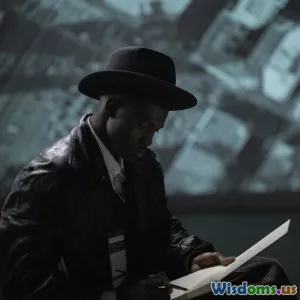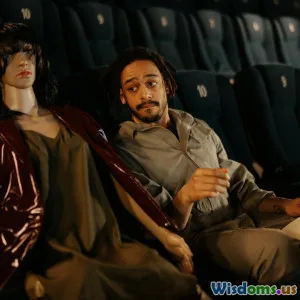
Reimagining Genres: Trends in Modern Filmmaking
7 min read Explore how modern filmmakers are reshaping genres to create unique, boundary-pushing storytelling experiences. (0 Reviews)
Reimagining Genres: Trends in Modern Filmmaking
Introduction
In an era saturated with content, the film industry faces an ongoing challenge: how to captivate audiences who are endlessly connected yet harder to engage. The magic lies not only in storytelling but in the evolving ways genres are approached. Audiences no longer seek cookie-cutter horror, straight-laced romance, or formulaic sci-fi. Instead, they gravitate toward fresh narratives that break the mold and surprise the senses. This article explores how modern filmmakers are reimagining traditional genres, blending styles, and embracing new techniques to redefine cinematic storytelling.
The Evolution of Genre: From Clear-Cut to Fluid Boundaries
The Death of Genre Purity
Historically, film genres were well-defined and marketed as distinct categories — westerns, noir, musicals, and so on. Each held specific themes, iconography, and emotional appeals. Today, rigid genre boundaries are dissolving. Consider critically acclaimed films like Quentin Tarantino’s "Pulp Fiction," which mashes crime thriller, dark comedy, and drama into a compelling narrative mosaic.
Film scholar Rick Altman notes, “Genres are not static; they evolve with culture and technology, reflecting society’s complexities.” The crossover of genres caters to audiences’ multifaceted tastes and signals filmmakers’ creative freedom.
Genre Hybrids: The New Normal
Movies increasingly blend elements from multiple genres to construct layered experiences. For example, "Get Out" (2017) combines horror with sharp social commentary and psychological thriller aspects, raising societal awareness alongside commanding suspense. Its success — over $255 million globally on a $4.5 million budget — attests to industry demand for genre innovation.
Similarly, "Parasite" (2019), winner of multiple Oscars including Best Picture, masterfully intertwines dark comedy, thriller, and socio-political drama, challenging cultural norms across global demographics.
Key Trends Shaping Genre Reimagination
1. Increased Diversity and Inclusion
Modern cinema reckons with representation not only in front of the camera but narratively. Diverse voices bring fresh perspectives that influence genre conventions. For example, "Black Panther" (2018) redefined superhero and sci-fi genres by injecting Afro-futurist aesthetics and African culture into mainstream Hollywood, generating both critical acclaim and cultural impact.
Additionally, female-led horror films such as "The Babadook" (2014) offer unique interpretations of common genre tropes, exploring mental health and grief rather than traditional jump scares.
2. Technological Advancements Transforming Storytelling
The cutting-edge use of technology increasingly impacts genre evolution. The rise of virtual reality (VR) and augmented reality (AR) promises immersive genre experiences that redefine audience engagement.
Films like "Ready Player One" (2018) epitomize this shift by marrying sci-fi and adventure using heavy visual effects to construct immersive universes. On a subtler level, sophisticated CGI and advanced sound design deepen emotional and sensory layers in even small indie productions.
3. Expanding the Scope Through Streaming Platforms
OTT (Over-the-top) streaming giants such as Netflix, Amazon Prime, and Disney+ have diversified how genres are explored and consumed. These platforms allow riskier projects that blend unconventional genre elements without the traditional pressure of box office returns.
For instance, Netflix originals like "Stranger Things" infuse 80s nostalgia with horror, sci-fi, and coming-of-age drama, successfully reaching niche and broad audiences simultaneously.
4. Psychological Depth and Moral Ambiguity
Modern genre films frequently emphasize psychological intricacies and moral complexities over black-and-white characterizations. This is notable in contemporary thrillers and superheroes, such as "Joker" (2019), whose narrative challenges the archetypal villain trope by exploring nuanced origins and socio-economic factors.
This trend reflects a broader societal appetite for stories that recognize human complexity and question traditional good vs. evil dichotomies.
Examples of Genre Reimagining
Horror Meets Art-House: "Hereditary" (2018)
Atypical within the horror genre, "Hereditary" blends familial drama, supernatural terror, and arthouse sensibility. Director Ari Aster’s approach opted for slow-building dread and symbolic storytelling, inspired by European cinema styles, elevating a genre often dismissed as lowbrow into critical acclaim.
Superhero Noir: "Logan" (2017)
Unconventional for the superhero genre, "Logan" incorporates western noir and road movie tropes with gritty character study. Its exploration of aging, vulnerability, and dystopia challenges the genre’s typical formulaic invincibility.
Sci-Fi Symphonies: "Blade Runner 2049" (2017)
Xbox relies heavily on visual storytelling and atmospheric depth that blends philosophical musing with futuristic noir aesthetics. This hybrid approach renews classic sci-fi while evoking existential questions that resonate with contemporary digital anxieties.
Conclusion
Modern filmmaking embraces a bold reinvention of genres by fusing diverse styles, voices, and technologies. The transformation from rigid category molds to fluid, hybridized narratives reflects evolving audience expectations and societal narratives. For filmmakers and viewers alike, this trend offers an exciting frontier where conventional storytelling is challenged and elevated to richer, more inclusive cinematic experiences.
As the film landscape continues to evolve, the future promises genres that are not just reimagined but revolutionized — where creativity transcends boundaries and stories resonate across cultural and technological divides. Both creators and audiences stand to gain from this imaginative redefinition, opening new pathways for storytelling that are as engaging as they are thought-provoking.
Whether you’re a cinephile, an aspiring filmmaker, or simply curious about film’s future, understanding these trends helps you appreciate the art form’s dynamic nature and anticipate the next wave of genre innovation.
Rate the Post
User Reviews
Popular Posts



















